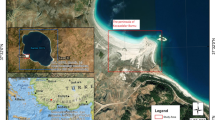Abstract
This work explores the potential of multispectral imagery in identifying dried and buried moats, and possibly any adjacent fortifications of medieval sites in South India. Vegetation marks in the form of geometrical patterns have been one of the key signatures indicating archaeological sites. To explore this three of well known sites from Karnataka in south India–Belur, Halebidu and Somanathapura–were chosen as their historical accounts mention that they were townships which had circumscribing artefacts such as fort/wall or moats that at present are not easily detected from conventional exploration. These three sites belong to Hoysala dynasty, a period when a systematic town planning was followed based on cultural aspects such as the religion or faith followed by the inhabitants of respective sites. Traces of specific configuration of moats can be detected around each of them. The present work investigates the possibility of identifying these artefacts on space imageries through spatial and spectral distinction along with synoptic views and use of appropriate image processing and analysis techniques.





Similar content being viewed by others
References
1934. Annual Report of the Mysore Archaeological Department for the Year 1930. Bangalore, India: The Government Press.
Agapiou, A., & Hadjimitsis, D. G. (2011). Vegetation indices and field spectro-radiometric measurements for validation of buried architectural remains: verification under area surveyed with geophysical campaigns. Journal of Applied Remote Sensing, 5(1), 053554. doi:10.1117/1.3645590.
Bradford, J. (1957). Ancient landscapes: Studies in field archaeology. London: G. Bell and Sons, Ltd.
Brivio, P. A., Pepe, M., & Tomasoni, R. (2000). Multispectral and multiscale remote sensing data for archaeological prospecting in an alpine alluvial plain. Journal of Cultural Heritage, 1(2), 155–164.
Brophy, K., & Cowley, D. (2005). From the air: Understanding aerial archaeology. Tempus, Stroud, Glos.
Chabries, D. M., Booras, S. W., Bearman, G. H. ‘Imaging the past: recent applications of multispectral imaging technology to deciphering manuscripts’. Antiqity, June 2003.
Deuel, L. (1969). Flights into yesterday: The story of aerial archaeology. Middlesex: Pelican.
Joseph, G. (2005). Fundamentals of remote sensing. Hyderabad: University Press.
Kamal, O. S., Ware, G. A., Houston, S., Chabries, D. M., Christiansen, R. W., Brady, J., & Graham, I. (1999). Multispectral image processing for detail reconstruction and enhancement of Maya murals from La Pasadita, Guatemala. Journal of Archaeological Science, 26(11), 1391–1407.
Lasaponara, R., & Masini, N. (2007). Detection of archaeological crop marks by using satellite Quickbird multispectral imagery. Journal of Archaeological Science, 34(2), 214–221.
Lau, D., Villis, C., Furman, S., & Livett, M. (2008). Multispectral and hyperspectral image analysis of elemental and micro-Roman maps of cross-sections from a 16th century painting. Analytica Chimica Acta, 610(1), 15–24.
Rajani, M. B. (2007). Bangalore from above: an archaeological review. Current Science, 93(10), 1352–1353.
Rajani, M. B., & Settar, S. ‘Application of multispectral remote sensing imagery in detection of ancient forts in South India’. In: Campana, S., Forte, M., Liuzza, C. (Eds.), BAR–S2118, 2010 Space, Time, Place Third International Conference on Remote Sensing in Archaeology, 17th–21st August 2009, Tiruchirappalli, Tamil Nadu, India. ISBN 978 1 4073 0659 9, pp. 123–127.
Settar, S. (1992). The Hoysala temples. Bangalore: Karnatak University and Kala Yatra Publications.
Settar, S. (2008). Somanathapura. Bangalore: Ruvari.
Acknowledgments
We thank Dr. V.S. Ramamurthy, Director, NIAS, and Dr. R.R. Navalgund, Former Director, SAC, for Institutional support and encouragement in carrying out this study. We also thank Prof S. Settar and Prof. B.V. Sreekantan at NIAS for useful discussions. The financial support for this project has been provided by Department of Space, Government of India.
Author information
Authors and Affiliations
Corresponding author
About this article
Cite this article
Rajani, M.B., Kasturirangan, K. Multispectral Remote Sensing Data Analysis and Application for Detecting Moats Around Medieval Settlements in South India. J Indian Soc Remote Sens 42, 651–657 (2014). https://doi.org/10.1007/s12524-013-0346-4
Received:
Accepted:
Published:
Issue Date:
DOI: https://doi.org/10.1007/s12524-013-0346-4




